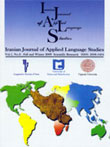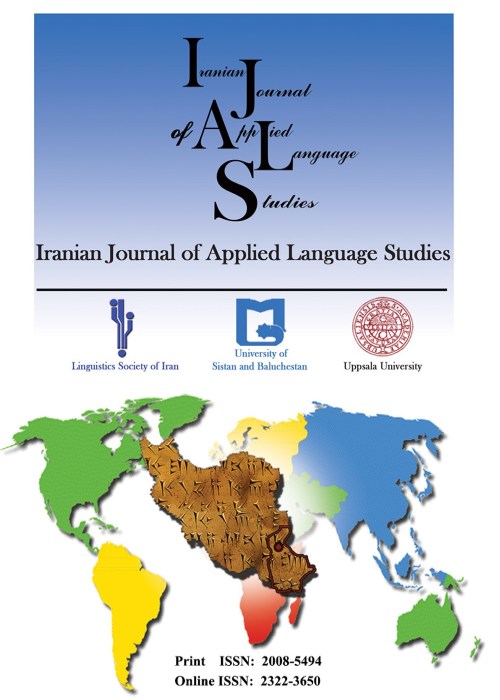فهرست مطالب

Iranian Journal of Applied Language Studies
Volume:5 Issue: 1, Summer and Autumn 2013
- 190 صفحه،
- تاریخ انتشار: 1393/06/25
- تعداد عناوین: 8
-
-
Pages 1-30Alternative assessment approaches received considerable attention soon after a discontent with traditional, one-shot testing. These approaches, however, have been used only to improve learners’ linguistic ability despite communicative models of language which pointed that knowledge of language also involves pragmatic ability (Bachman, 1990; Bachman & Palmer, 1996). The present study tries to explore the effect of two alternative assessment approaches (self-assessment and conference) on students’ production of four speech acts (apology, complaint, request, and refusal) plus politeness markers. A sample of 64 EFL students participated in this study. Metapragmatic explanations were given to three groups of university students studying English as a foreign language. The two treatment groups received instruction through self-assessment and conference and a comparison group was exposed to the conventional one-shot testing. The results of the One-Way ANOVA conducted after the treatment revealed an outperformance of alternative assessment approaches to the conventional one in the production of the four speech acts and politeness markers in WDCTs. A qualitative analysis of students’ self-ratings in the self-assessment group revealed that they focused more on linguistic criteria during the initial sessions and on pragmatic ones by the end of the treatment. It can be concluded that alternative assessment approaches are beneficial to students’ production of speech acts and politeness markers. In the end, the applicability and the positive effect of alternative approaches in pragmatic assessment are emphasized.Keywords: Alternative Assessment, Interlanguage Pragmatics (ILP), Pragmatic Assessment, Conference, Self, assessment, Metapragmatic Awareness, Written Discourse Completion Test (WDCT)
-
Pages 31-46The current study was carried out to investigate the functions of the ritual speech act of ‘ya Allah’ (literally meaning ‘O God’) employed by Iranians in social interactions. To this end, sixty-two Persian native speakers of different age groups, ranging from 35 to 85, of both genders were observed in 250 natural situations such as daily interactions, gatherings, public or private places and local TV programs until the saturation point. Their verbal interactions were recorded, transcribed and later analyzed. Moreover, in order to corroborate the representativeness of samples, ten people were interviewed and were asked directly when they utter ‘ya Allah’. It was concluded that the speech act may be employed in either religious or non-religious contexts to serve two major functions: to ask for permission (to enter a place) or call for an action. Moreover, the two major functions of the speech act in question may be broken down into nine minor functions: (1) Declaring one’s entering a house/apartment/orchard, tent or the like to be allowed or welcomed by the owner/insiders; (2) Warning intimate women to observe their hijab, when a strange man is to enter; (3) Entering a place in general, especially employed by men; (4) Being late to join community prayers; (5) Greeting someone who has just joined a group; (7) Commencing an action; (8) Asking someone to hurry up and (9) Doing something difficult with the help of others unanimously.Keywords: Speech Act, Ritual Speech Acts, ya Allah', Social Functions, Religious Functions
-
Pages 47-76This study investigated the impact of using the technique of self-monitoring on non-academic EFL learners’ composition writing. Fifty female students studying English at Navid English Institute in Shiraz, Iran were chosen based on the results of a proficiency test. They were all 16-20 years old and were intermediate learners of English who were divided into two control and experimental groups and took a writing pre-test. The experimental group (EG) received a training program on the effective use of the technique of self-monitoring proposed by Charles (1990). That is, they learned to add annotations expressing doubts and queries on various parts of their five composition drafts. The students in CG wrote their drafts without annotations. At the end of the twenty-second session course, both groups took a writing posttest. The results indicated that the learners in EG performed significantly better and the global features of organization and content in their writing were enhanced. Surveying the students’ views on self-monitoring, through a questionnaire, revealed their interest in taking charge of their writing task. Findings point to the efficacy of the self-monitoring technique in promoting learners’ writing proficiency and autonomy in handling writing tasks.Keywords: Writing, Self, monitoring, Local, Global Aspects of Writing
-
Pages 77-100The present study sought to investigate the evidence for cross-linguistic transfer in a partial English immersion and non-immersion educational setting. To this end, a total of 145 first, third and fifth graders in a partial English immersion program and 95 students from the same grade levels in a non-immersion program were chosen. Six different English and Persian tests were administered: the Cambridge English for Young Learners (YLE) Test for Reading, a Persian reading achievement test, the English and Persian Phonological Awareness Sound Detection tests and the English and Persian Rapid Automatized Naming Tests. Given the nature of the research question and the design of this study, linear regression analysis was run through Statistical Package for Social Sciences (SPSS). The findings suggest that there is an apparent cross-linguistic transfer between English reading achievement and Persian cognitive predictors in both educational settings. Relatively speaking, Persian cognitive predictors can moderately predict English reading achievement in Grades 1 and 5 and can weakly predict English reading achievement in Grade 3.Keywords: Cross, linguistic Transfer, Phonological Awareness, Rapid Autamatized Naming, Bilingual Education
-
Pages 101-116In this research, different English translations of Sa‘di’s Bustan were studied. An anecdote was selected randomly with its three English translations to identify whether or not the translators have managed to convey the messages of the original poem. The three selected translations were examined according to two of the criteria that Larson (1984) has proposed (accuracy and naturalness) for testing a translation. By accuracy, the researcher intended to see whether, the translators have been successful in rendering the SL text accurately and precisely without radical changes, omission and addition; and by naturalness, it was meant whether the translations sound natural or they contain strange and foreign words. The results of the study show that Edwards has been successful in understanding the main idea of the original poem and conveying it into prose. Clarke’s translation is word-for-word and being literal, the natural criterion has been breached in some instances. Wickens’s has attempted to transfer the exact meaning of the original to the target text. Among the three translations studied, that of Wickens is considered to be the most accurate one.Keywords: Poetry, Methods of Translation, Literary Translation, Accuracy, Naturalness
-
Pages 117-154The aim of the present paper is to study the status of the short vowels /i/ and /u/ in five selected Iranian Balochi dialects. These dialects are spoken in Sistan (SI), Saravan (SA), Khash (KH), Iranshahr (IR), and Chabahar (CH) regions located in province Sistan va Baluchestan in the southeast of Iran. This study investigates whether these two vowels have the same qualities as the short /i/ and /u/ do in the Common Balochi inventory (i, iː, u, uː, a, aː, eː, oː). The Common Balochi inventory is the vowel system represented generally for Balochi language, which is a North-Western Iranian language, a sub-branch of the Indo-Iranian family. The data for this survey are gathered from villages, rural areas, and cities in these regions in the forms of free speech and verbal elicitation from more than 20 literate and non-literate male and female language consultants, 2 males and 2 females for each dialect. The investigation reveals that the short /i/ and /u/ show strong tendencies towards a lower position. This study suggests phonemic systems in which the short /i/ is modified to short /e/ in all dialects, but /u/ is modified to /o/ only in SI, SA, and CH; the lowering of the short /u/ to short /o/ in KH and IR may still be in the transition stage. It is possible that Persian, as the dominant language has had its influence on these dialects causing a lowering tendency in the two vowels under study.Keywords: Balochi, Iranian Balochi Dialects, Common Balochi, Vowels, Language Contact, Persian
-
Pages 155-170This article was written based on the key concept of polysystem theory which, in translating any literary text, emphasizes the transference of the social systems in which a text is embedded. As stated by Tynjanov (1978a), polysystem theory saw translated literature as a system operating in the larger social systems of the target text. Thus, the task of understanding as well as transferring such systems in their translations, which can certainly affect the readers’ adequate understanding of texts, is a challenging job for most of the literary translators. After identifying three main social systems in The Great Gatsby as the corpus which was ranked second in the lists of the 100 Best Novels of the 20th Century, the source and the target texts were studied attentively, to study the way the respective systems were translated by the Iranian literary translators. Therefore, the prominent element of Nord’s textual analysis (1991), macrostructure, was focused throughout data collection procedure. Then, it was demonstrated that especially through an appropriate transference of the major conflict between the two predominant classes in the novel, the translator has managed to suitably convey most of the text’s social systems in his translation. Finally, it could be deduced that most of the literary translators in Iran, somehow transferred the concerned systems into some significantly adequate equivalents in their works.Keywords: Polysystem Theory, Social Systems, Transference, Literary Translation
-
Pages 171-189Intercultural communication takes place when individuals influenced by different cultural communities negotiate shared meanings in interaction. As every country has its own cultural value system; consequently, nonverbal communication is different from country to country. Therefore, having knowledge about the similarities and differences of nonverbal communication in different cultures increases the possibility of being understood and reduces the risk of being misunderstood and misinterpreted by people from different cultural backgrounds. The current paper aims to investigate and compare the interpretations of nonverbal messages between the findings of Pease and Pease (2004), two prominent figures in the field of nonverbal communication in Western societies and the Iranian students of English and non-English major as an example of an Eastern society. In this study, 32 body gestures were selected from among 170 pictures used by Pease and Pease (2004) and the Iranian students’ interpretations of those body gestures were investigated. The results showed that the interpretations were significantly different across Western and Iranian students; however, there was no significant difference between English and non-English major students’ interpretations.Keywords: Intercultural Communication, Nonverbal Messages, Body Language, Western, Iranian Nonverbal Interpretations


